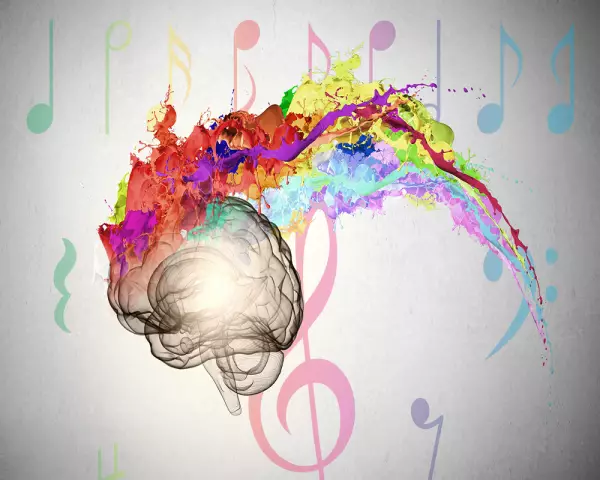- Author Rachel Wainwright [email protected].
- Public 2023-12-15 07:39.
- Last modified 2025-11-02 20:14.
Synesthesia

Anesthesia (insensibility) is the opposite of the word synesthesia, in which a person receives several sensations when only one analyzer is irritated. As you know, human sensitivity is determined by five analyzers, each of which is responsible for certain sensations:
- Spotting;
- Hearing aids;
- Olfactory;
- Flavoring;
- Tactile.
The sixth analyzer is scattered throughout the body at the points of attachment of muscle tendons to the skeleton and is called proprioceptive. However, the "sixth sense" does not apply to synesthesia. Proprioceptive sensations are regulated by the vestibular apparatus, while all other analyzers are influenced by the limbic system. It is located in the hippocampus, the so-called "olfactory brain". This is the very first gyrus in the cerebral cortex, which is united by the corpus callosum. This is a kind of bridge between the left and right halves of the brain. The manifestations of synesthesia indicate a violation of synchronicity between the cerebral hemispheres. Therefore, a person who is synesthetic, most often, has the same right and left hand. He can be called a hidden left-hander, but more correctly, nevertheless, a universal.
Types of synesthesia
When, when one of the analyzers is stimulated, a person has clear associations with another - this phenomenon is called synesthesia, that is, it indicates a connection between two completely different sensations.
By the nature of additional sensations, synesthesia is divided into the following types:
- Visual (photism);
- Auditory (phonisms);
- Flavoring;
- Olfactory;
- Tactile.
The most common form of synesthesia is the color scale in the mental presentation of an object. For example, the number "one" appears to be colored black to the synestheticist, and the number "two" appears to be purple.
Auditory synesthesia is characterized by associations of sounds with specific colors. A person listens to classical music and presents it in colors.
Gustatory synesthesia is characterized by the perception of an object or even a subject in conjunction with a particular taste. Man connects the sun with sugar, although he himself cannot explain the logical chain between these objects. And, most importantly, after many years, the sensations of synesthesia remain the same. Therefore, the appeal: "Sweetheart you are mine!" - in relation to an infant for a synesthetist is not an isolated impression. Any child for such a person will always be associated with the sensation of sweetness on the tongue.
The phenomenon of synesthesia
The main characteristics of true synesthesia, in contrast to false synesthesia, are involuntary emergence and complete uncontrollability by consciousness. If a person sees the number "one" in black, and the number "two" in purple. That number twelve will be colored with a black and purple stripe. Two hundred and twelve, respectively, will have two purple stripes, and between them - black. And no other associations will appear, regardless of the will of the synestheticist. The image can only change in color intensity, which depends on the emotional mood of a person.
The phenomenon of synesthesia is always constant, due to the formation of a stable pair: “stimulus - synesthetic image”. If rain noise appears to be orange, it will never be perceived as yellow or red.
False synesthesia
Pseudosynesthesia is never inherited, unlike true synesthesia. Moreover, it is caused by certain factors.
The false phenomenon of synesthesia has very specific reasons:
- Taking hallucinogens. Under the influence of hashish or LSD, a person experiences distortions in perception. The addict also “hears colors” or “recognizes sounds by smell”. But with the next dose, all his sensations can change dramatically. What he perceived to be blue becomes green for some reason, and so on;
- Lesion of the hippocampus. A tumor or trauma to the brain results in olfactory hallucinations that have no specific connection to each other. Any sounds "smell" the same, differing only in intensity. Pathology cannot be called synesthesia;
- Rooted conditioned reflex associations. When a person hears the signal for dinner, he smells the kitchen. Or the sound of an alarm clock reminds of mint toothpaste - associations that have been remembered from early childhood.
True synesthesia does not require additional stimulants, training to consolidate the conditioned reflex and childhood memories.
Synesthesia in psychology
The phenomenon of synesthesia in psychology defines people who have the ability to clearly link objects with the help of two or more senses, gifted individuals. They don't have to be outstanding talents or geniuses, but certainly people with phenomenal memory.

The hypothesis about the connection between memory and synesthesia was tested by the following experiment. The examined woman was presented with matrices consisting of 50 digits. The subject without hesitation from memory was copying on a sheet of paper all the numbers that were shown to her for several seconds. Moreover, 48 hours later, she repeated the test with the same result, without looking again at the presented numbers in the matrix. Experience explains why synesthesia can help you remember unfamiliar and unrelated objects. For each number, the woman had her own color scheme, which was remembered as a painting. Such works of art are painted by abstract artists. Perhaps synesthesia in psychology will one day explain to people how such pictures should be perceived.
Synesthesia and psychiatry
The phenomenon of synesthesia has been known to psychiatrists since the late 19th century. Many people have been studied, including famous writers, composers, artists. With the exception of increased emotionality, no mental abnormalities were found. The incidence among persons with synesthesia abilities was at the same level in the general population.
Found a mistake in the text? Select it and press Ctrl + Enter.

